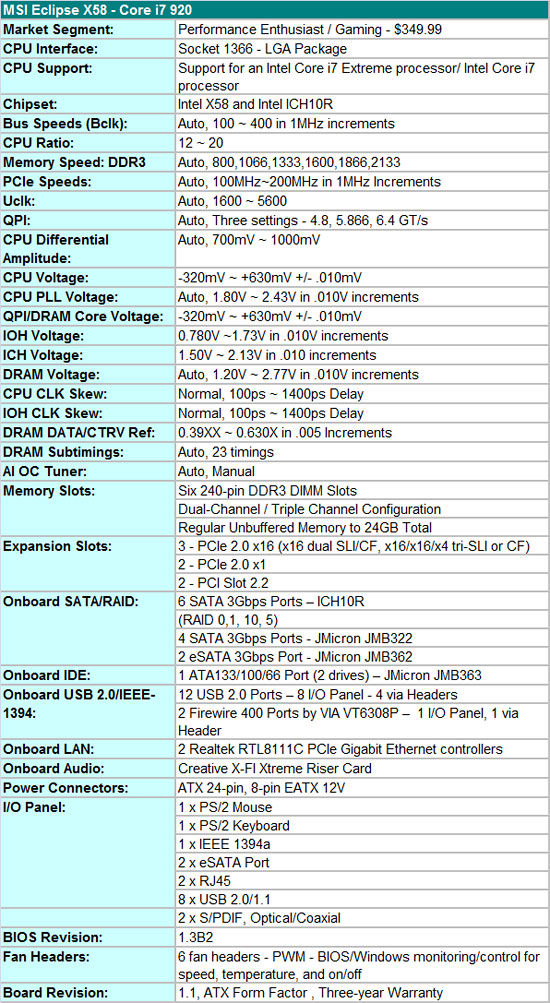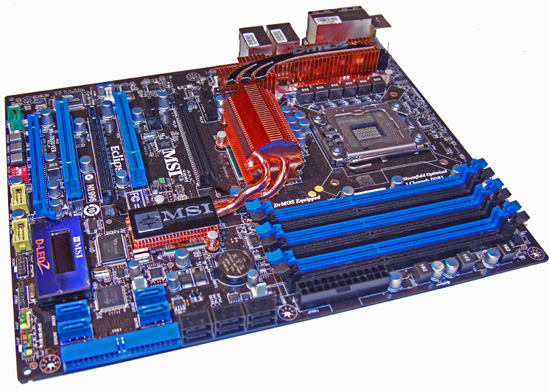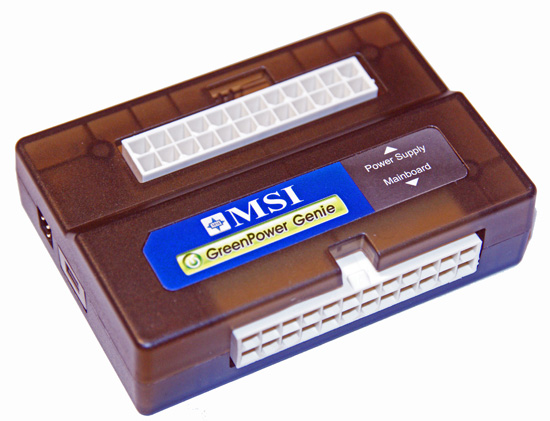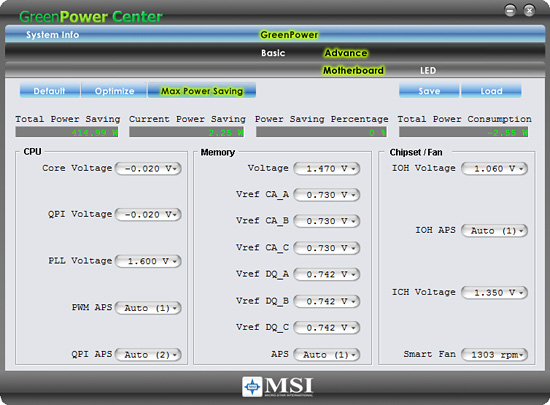Intel X58 Motherboard Roundup - What does $300 Get You?
by Gary Key on December 5, 2008 3:00 PM EST- Posted in
- Motherboards
MSI Eclipse X58
Features

The MSI Eclipse X58 is a feature laden board from a hardware and software viewpoint. It should be considering the $350 price tag, although there is a $30 mail-in-rebate at present. The almost universal Realtek RTL-8111C PCIe Gigabit Ethernet controllers are utilized in tandem; a riser card featuring the Creative Lab's CA0110-IBG chipset provides HD audio and EAX 5.0 capabilities; JMicron’s JMB 363/362/322 chipsets are tabbed for eSATA, IDE, and additional SATA port duties; VIA's VT6308P provides IEEE 1394a support; and the Intel ICH10R is utilized for primary storage purposes.
The BIOS is designed for overclocking duties, although it's not as comprehensive as those from ASUS or Gigabyte. However, it is fair to say that several of the options that ASUS and Gigabyte provide will never be touched by about 95% of us when overclocking. Our main knock against the BIOS is that it is not as user friendly as the others in this roundup. We do not care for the +/- voltage settings as it becomes confusing for the user to understand exactly what effect their changes had on the particular option, especially without knowing what the base voltage is set at.
MSI supports stock memory speeds up to 2133MHz on the i920/i940 processors along with opening up QPI link speeds from a standard 4.800 GT/s up to 6.400 GT/s, which is standard on the i965 Extreme processor. The board fully supports 24GB of DDR3 memory. We have a 24GB kit arriving shortly for testing so we cannot confirm compatibility yet, but we trust MSI in this regard.
In the meantime, we have not had any problems running 12GB with our Patriot or G.Skill DDR3-1600 kits up to 1600 at 9-8-8-24 1T timings, although we needed about 1.68V for absolute stability with the i920 at stock speeds. Dropping the command rate to 2T allows 1.64V operation with the current BIOS. Overall, memory performance is very competitive with the other boards and improving in each BIOS release. However, this is the only six slot board that we have been unable to clock a 12GB configuration up to a 191x21 setting. The board stops around a 175 Bclk with an 8x memory multiplier that results in a DDR3-1528 speed. The board will clock up to a 191 Bclk with the memory multiplier at 6x, which results in a DDR3-1146 setting. MSI is working on improving this area.
The Eclipse board contains three PCI Express 2.0 x16 slots that operate in x16/x16 mode for 2x SLI/CF. The third x16 slot operates in x4 mode regardless of the second slot population. 3x SLI/CF configurations run in x16/x8/x8 mode on the EVGA and Gigabyte boards. We did not notice any performance differences between the x16/x16 or x16/x8 operation in 2x CF with our HD 4870 cards. However, we just received a new BIOS from MSI that allows 3X SLI/CF to operate properly. We will update the article in a few days with a comparison between the boards utilizing all three x16 slots. We had no problems running our ASUS Xonar D2X or Highpoint Rocket RAID cards in slots two or three.
The Board


The Eclipse X58 is MSI's current flagship board with the recently introduced Platinum X58 filling a void in the low end X58 market with a $220 price tag. While $220 is an awful lot for a motherboard, it's practically a bargain in this particular market sector. Of course, you give up a few items like SLI compatibility, an additional x16 slot, and the JMicron SATA ports, but for a lot of users those features are not that important.
MSI went a different direction with this board compared to earlier designs; gone is the roller coaster or circular heatpipe design, as is the traditional fire engine red color scheme that is now a subdued black and blue color palette. While colors do not determine the performance of a board, they do tend to make a difference in first impressions. We like the new color scheme and sincerely appreciate a more traditional heat pipe setup. In fact, MSI skipped on an elaborate heatpipe setup found on other boards and concentrated on cooling the voltage circuitry separately, although the northbridge and southbridge are still linked together.
The CPU area is fairly open and our larger air coolers did not pose a problem. The Eclipse board features a two-phase power delivery system for the northbridge and for the memory subsystem. A six-phase power delivery design is utilized for the processor, half that of the Gigabyte and ASUS boards. However, this did not adversely affect the overclocking capabilities of the board. MSI utilizes high quality solid-state capacitors and ferrite core chokes on the board.
The general layout is very good as MSI has managed to situate the vast number of ports, slots, and hardware in a manner that keeps them from interfering with installed peripherals. MSI managed to squeeze three PCI Express 2.0 x16 slots (x16/x16/x4), two PCIe x1 slots, and two PCI slots. This arrangement allows 3X Crossfire or SLI and still leaves a single PCIe x1 slot open. However, using a double slot card in the third slot will make it extremely difficult to utilize the power, reset, IEEE 1394a, and USB ports. Our opinion about 3X CF/SLI is not that high unless you are benchmarking for 3DMark records, so we appreciate the fact that a 2X CF/SLI arrangement will leave a PCIe x1, PCI, and PCIe x16 (x4 electrical) slot open.
On the bottom of the board you will find onboard buttons for power, reset, and the D-LED 2 display module. The D-LED 2 is handy for a quick glance during the POST process or you can have it display VCore or northbridge voltages along with pinpointing a particular temperature on the board with the included 20" probe. The D-LED does not display hex codes, instead relying on short hand messages like "DDR Ini" during post processes.
While we appreciate the D-LED, it is really only good for windowed cases or open platform testing. We think MSI should have included an attachment cable that allowed placement outside of the case. Also, the unit does not live up to its potential by providing additional hardware monitoring capabilities such as temperatures, fan speeds, or other voltage readings. Of course, MSI has monitoring software that accomplishes these tasks, but we think a hardware solution would be better, especially considering the cost of the board.
The IO panel features eight USB 2.0 ports, two Ethernet jacks, an IEEE 1394a port, and two eSATA ports courtesy of the JMB 362 chipset. MSI also includes an expansion slot backplate that allows an additional two eSATA ports via any of the board's internal SATA connections. An audio output panel is missing since MSI utilizes a riser card that features Creative Lab's CA0110-IBG audio chipset.
Our first reaction was very positive until we looked at the chipset specifications and realized that hardware audio processing capabilities - including the EAX 5.0 implementation - are done through software and the CPU. Also, most of the software features from a standalone X-FI card are not available in the software package that MSI provides. They did include access to Creative's 24-bit Crystalizer and speaker virtualization features along with other hardware settings.
Of course the big question is the audio quality provided by this solution. RightMark Audio Analyzer indicated poor THD and inter-channel leakage, but in actual usage we could not tell any real differences between the Creative and Realtek solutions in music playback quality. The ADI solution on the ASUS board sounded a bit clearer and dynamic in music playback. In gaming, we thought the Creative solution was slightly better than the ADI chipset and noticeably better than the Realtek solutions on the Gigabyte and EVGA boards. If gaming or music playback is a priority, we still suggest an add-in card for best performance.
The Application


MSI features a unique power saving system on the Eclipse. They include a GreenPower Genie pass-through connector that attaches to the 24-pin ATX power supply cable and a cable that attaches to the 24-pin ATX connector on the motherboard. There is also a two-pin cable that attaches to the Genie and the motherboard that works in conjunction with the the GreenPower software to monitor and dynamically reduce power usage.
This system will automatically scale the number of active power phases for the processor, memory, and northbridge. We noticed savings of 9W at idle, so it actually works. In fact, it provides better results than the ASUS EPU-6 or Gigabyte DES power saving systems. During testing, it was able to switch fast enough so we did not have to worry about program crashes when utilizing GreenPower. The one drawback is that the pass-through connector and cable is a bit cumbersome to use in smaller cases.
















78 Comments
View All Comments
TeXWiller - Friday, December 5, 2008 - link
Are you sure the 6 DIMM configuration is even supported with the current Nehalem at DDR3-1333 speed? Supermicro X8SAX, for example, does not support 6 DIMM configuration over DDR3-1066 speed, which is also the maximum Intel supported speed. This might explain some of those POST related problems.javamann - Friday, December 5, 2008 - link
I usually go for the high end board but I don't overclock. I expect if a board is built to run at a higher speed running at a normal speed would sit in the middle of the bell curve of it operating parameters. I would also expect it to just work. My bad.mjz - Friday, December 5, 2008 - link
not having support for 24GB ram of the bat is ridiculous.. With DDR3 ram going to be at a decent price next year, why not??? having 15GB as a ram disk would be amazing for many people.. this is MB companies being lasyAeroWB - Friday, December 5, 2008 - link
"Hey guys, Anand here. I'm writing this sub-section, not at Gary's request, but because I felt it was necessary."I totaly agree with you here, thanks for letting us know the size of the problem and Gary thanks for all those fixes.
"The point being is that we feel the lack of quality assurance before a product hits the market has now reached an all time high."
I do believe this is true, and I also have to say that I'm having problems with these kind of things for quite some years now, and I'm getting sick and tired of this.
For me the crap kickstarted in 2001 with an MSI mainboard, one brand I will never buy again...
(2001) MSI K7N420 Pro, it took MSI half a year to fix the issue of not being able to run the ram in dual channel mode on default speed without data corruption (the year I learned about memtest86) Also this board could not boot from an LSI 21320-R SCSI card and that problem has never been fixed (the Asus board with the same chipset could do it but my attempt to put that bioscode in the MSI bios failed)
(2003) Asus A7N8X-E Deluxe. onboard Marvell Gigabit card corrupted data, about one bit each 2GB so all my DVD downloads were corrupt! at 100Mbit it worked ok, an add-on Gb card also worked ok, lots of bios updates, no solution. Here's probably too much controllers cramped in not enough space. After 3 years upgrading the ram to 2GB didn't work, tried a lot of different brands. Bought an Intel D975XBX. (but the asus did support my LSI SCSI card!)
(2005) SuperMicro PDSGE, I finally bought a board with PCI-X for my Netware Server with SmartArray controller (which before was running in an Intel D945GTP desktopboard on PCI). The SmartArray card would boot, I got 2 special biosses for the board from Supermicro (great supportteam) but could't get it to work so added extra disk to boot the system, problem never solved. but it seems strange the controller working on a desktopboard and not on a server board. Updating the SmartArray also didn't help, My server still runs this board but now has a never HP SmartArray 641 that does work.
(2008) Asus M3A78-T, Razer Lachesis mouse is not working when powering up, I have to reinsert the usb connector of it everytime I start the computer to get it working (standby doesn't help) In 4 months I have flashed 3 newer bios versions in the mainboard and 2 in the mouse. Problem still exists. The Lachesis works fine in my IntelD975XBX system. My Razer Copperhead works fine in both (so I swapped the mice)
All listed boards are only from my private systems, I work at a computershop for over 10 years so needless to say I saw much more bios/board misery.
So far I have had the least problems with Intel boards but they also have their share of problems. Some years ago the company switched from Asus to Intel partially because alot of customers sometimes accidently overclocked their system (the boards got into the bios if they thought the post failed) and it got unstable. I really do not get why there are so many overclocker options while 90% of the people doesn't use it and just want a stable system. If for example I now look at Asus' website I almost get a heart attack, there are just too many mainboard models, most are not interesting at all, too many useless onboard crap, too expensive, absurd features (Aopen tube board for example), crap quality chipsets, etc. And in all that mess there's no board without overclocking and quality components except maybe some Intel models. Try to find a board that will get your vidcard and soundcard a real free non-shared interrupt, you can't. So there is too many stuff and not enough simple quality models. How can they test and support all those models, well they can't as we know now. They don't update drivers for their chipsets and onboard junk, so you have to search yourself. It looks like they haven't got enough time to do it good so why not make less models and get it working right. All of this holds true for many brands not only Asus. Maybe the economic crysis will have a positive side-effect of getting less different models but better supported and tested components.
Only pointing the finger at the manufacturers however is too easy.
Lots of review-sites focus on speed and overclocking, exagerating speed differences, over-hyping all kind of not-so-usefull onboard junk. Its all speed and quantity for the least money, so boards come factory overclocked, memory timings set to tight, onboard controllers that almost no-one needs etc. Just so it looks they provide more bang for the buck then the competition and get a better review score.
Lots of customers want the most speed and features for the least money, and forget about quality, support etc. Manufacturers look at the market and provide the crap that people scream for to get bashed by those customers for the crap, that will still buy the cheapest stuff next time. so the demand for shit doesn't decrease so the shit is provided again....
chizow - Friday, December 5, 2008 - link
I've felt the motherboard industry has been the weakest link in the PC industry for a very long time. I'm really glad someone finally called them out on it.I used to get REALLY upset at AT reviews because they'd publish a review making it seem these boards are rock solid stable with insane overclocking ability only to learn the ugly truth once I got the board home. It wouldn't take long to confirm it with other reports of underwhelming performance totally out of line with various reviews.
BIOS stability and quality certainly needs to improve, especially if board makers want to charge such insane prices for something that has always seemed low-end and interchangeable. Its probably a good thing that the market for mobo makers has shrunk, now they can focus on quality and add some value by making these things last longer than 6-9 months.
haukionkannel - Friday, December 5, 2008 - link
When I bought last time purhaced new PC. It had vorce USB support that I can imagine. Every time I put an new USB devile like USB stick, the computer freeces down after short or long period of time... Ower the years situation got better and better. But It reguired a lot of installing of new versions of Bios... And yeh, it was expensive motherboard from big maker.I am allmost somewhat customed to that the computer does not properly... and that is something that is not right! It should work better from the beginning.
Maybe we need some form of ISO standard for new mother board:
When these and these things works. You can start selling these items and review sites starts makin revies of them. Prewievs and beta programs are different story all to gether, but final product shoulf be better.
Now we only need a forum where to make that standard. I am quite sure that testers are even more frustracted with stupid errors they encounter than I who has never been "huge" over clocker.
- - - - - -
1) The machine must works with all specified memory configurations
2) Informed normal speeds should work with all integrated parts
3) the machine should be stable enough to run 24 hours burn test with adverticed speed specifications.
4) If you allso overclock it 10-20% That is good extra, but I expect more of these after more mature bios.
This list is not accurate enough, but somekind od insurance is needed! I Thank you for your hard work. For normal user these test you make are the only way of getting to know who can still make desent bios and who can not!
karhill - Friday, December 5, 2008 - link
"Catering or focusing exclusively to the extreme overclocking community has resulted in initial product launches that are focused on getting the highest possible results from a product at the expense of usability, compatibility, and stability."EXACTLY. Board stability and features that work are SO MUCH MORE IMPORTANT to me than overclocking. When I buy a board, that's what I'm looking for: stablity and features that work. Any consideration of overclocking is simply as an indicator for the qualities that matter to me; that is, I figure if board overclocks well, then it ought to be extra stable at stock speeds.
TennesseeTony - Friday, December 5, 2008 - link
The ASUS P6T Deluxe sounds exactly like what you've been describing. Screw 12GB of RAM, I can't get six 1GB sticks of OCZ-1333 to boot/post. 3GB great. 4GB, fine, no problem. 5GB, yep, works just fine. But put that sixth stick of memory in there, in ANY of the slots, and when that little annoying blue led by the mem slot turns on, the computer dies.Vista won't boot on the SAS controller (64bit). ASUS says it's Microsoft's problem, nothing wrong with them... XP64 finally loaded up, I think I'm on Windows installation number 14, still buggy.
I've been quite pissed with Anandtech for not coming through with all the promises of overclocking guides and such, but thank you, Anand, for finally shedding some light on the problems behind the delays, and an extra big thank you for deciding to only give them two strikes, then they're out! It's far past time!
pwndcake - Friday, December 5, 2008 - link
So, the motherboard companies are using yours and other tech sites for free QA testing? Am I reading this right? Not a bad idea really. They don't even have to pay the price of 12GB of RAM to get all the testing and feedback they need.tmath2 - Sunday, October 4, 2009 - link
Hear Hear !!! Call it like you see it! The though had occured to me also that the mob mfr's could save a ton on salaries by out-sourcing the Quality and Assurance departments to AnandTech and other hardware review websites!